
|
Thursday, February 10
2:30 p.m. Theoretical Physics Seminar - Curia II
Speaker: F. Cachazo, Institute for Advanced Study
Title: New Techniques in Perturbative Gauge Theory:
Tree and One-Loop Calculations
3:30 p.m. DIRECTOR'S COFFEE BREAK - 2nd Flr X-Over
THERE WILL BE NO ACCELERATOR PHYSICS AND TECHNOLOGY
SEMINAR TODAY
Friday, February 11
3:30 p.m. DIRECTOR'S COFFEE BREAK - 2nd Flr X-Over
4:00 p.m. Joint Experimental Theoretical Physics Seminar - 1 West
Speaker: T. Tait, Argonne National Laboratory
Title: Z' Searches in Run II
|



Thursday, February 9
Minnesota Wild Rice with Chicken
Tuna Melt on Nine Grain $4.75
Breaded Veal with Mushroom Cream Sauce $3.75
Sweet & Sour Pork over Rice $3.75
BLT Ranch Wrap $4.75
Cheesey Breadsticks $2.25
Chicken Pecan Salad $4.75
The Wilson Hall Cafe now accepts Visa, Master Card, Discover and
American Express at Cash Register #1.
Wilson Hall Cafe Menu
Chez Leon will be closed through January and February
|


|
 |
Universities Help on the Tevatron
This article is the fifth in a series that will focus on the benefits of
Fermilab/University collaboration on different accelerator projects.
|
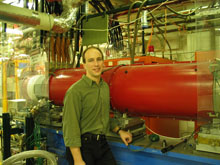
|
|
Kip Bishofberger with a prototype of the TEL electron gun. (Click on image
for larger version.) |
|
|
Many university accelerator projects involve solving problems or improving
performance. "Accelerator physicists work on a tight schedule," said Alvin
Tollestrup of Fermilab's Experimental Particle Physics Division. "Most
universities have little experience with the accelerator environment — the
24-hour monitoring and all the potential repercussions of the system on other
experiments."
One successful collaboration includes the building of the Tevatron Electron Lens
(TEL), which started in 2000 at the beginning of Run II. The TEL, attached to
the Tevatron, performs two functions. When opposing proton and antiproton
bunches collide, only a few particles actually interact, but the other particles
are slightly scattered. In "beam-beam compensation" the TEL shoots an electron
beam that interacts with the antiprotons, which reverses this scattering and keeps
the bunches compact. Additionally, the TEL "sweeps out" particles that have
escaped from the bunches into the abort gap, an issue that otherwise would
severely handicap the Tevatron.
"The TEL is the only thing in the Tevatron that can be adjusted fast enough
to target each bunch independently," said Bishofberger. "After installing it,
we succeeded in our goals within a couple months. Today, the first TEL is
being used continuously and a second TEL is being built. I'm so excited
to be part of a project that has such an immediate effect on today's colliders.
It's making a difference right away."
Other university groups contributing to Tevatron performance include Ludovic
Nicolas from the University of Glasgow, who is working with Nikolai
Mokhov on beam vacuum effects as well as radiation background simulations.
"Fermilab is like a great playground for students doing research," said
Nicolas. Also, Jia Ning from the Illinois Institute of Technology is
working with Chen-Yang Tan of the Accelerator Division on a transverse
beam frequency response simulator, which will conserve machine studies
time. Carol Johnstone and Valeri Lebedev of Fermilab's Accelerator
Division have worked with Michigan State University students on beam
lattice calculations, as well.
Next: ILC
|


FYI: AIP Bulletin of Science Policy News, February 9, 2005
Tight Budget Times: DOE Office of Science FY06 Request
The underlying theme at the release of the Department of Energy's FY 2006 budget request was the need to rein in federal spending. The total DOE budget would drop 2.0 percent under President Bush's FY 2006 budget request, from $23.9 billion in FY 2005 to $23.4 billion. For DOE's civilian research, the Office of Science (SC) would see its budget reduced by 3.8 percent from FY 2005 funding of $3,599.6 million to $3,462.7 million. The FY 2006 requested amount is, in fact, also 2.0 percent lower than the office's FY 2004 funding. According to DOE documents, much of the reduction comes from the elimination of $79.6 million in congressionally directed earmarks to Biological and Environmental Research, and the reduction to the budget for core SC programs is only 1.6 percent.
read more
|
|
 |

Delving for Dibosons at DZero
|
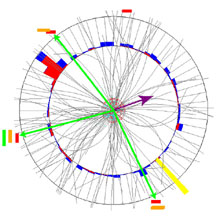
|
|
End-on view of one of three WZ events. The collision
occured at the center of the detector. A Z boson decayed to two muons
(two of the green tracks). A W boson candidate decayed to a muon and
a neutrino (a green track and purple arrow opposite to it). Other lower
energy charged-particles were produced in the collision and are represented
as grey tracks. The straighter the track, the more energetic the particle.
The red and blue towers in between the dark circles represent energy deposited in
DZero calorimeter by the particles created in the collisions. (Click on image
for larger version.) |
|
The W and Z bosons are particles that carry the weak force, one of the four
fundamental forces found in nature. According to the Standard Model, the W and Z
bosons interact with each other due to their weak charge. At Fermilab, we
measure the strength of the interaction of the W boson with the Z boson
by identifying and studying collisions in which both are produced at the
same time. By counting the number of occurrences and measuring the properties
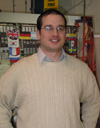
|
James Degenhardt
(above)and Bing Zhou
(below),both of Univ-
ersity of Michigan, have
worked on this analysis.
Not pictured are Qian
Xu, Michigan, and Tom
Diehl, Fermilab, who
also worked on it. |
of the WZ events, we can test the strength of the interaction between the bosons.
W and Z particles are very massive. The W boson weights 85 times the mass
of a proton. The Z boson is even heavier. Shortly after they are produced,
W and Z bosons disintegrate into lighter types of particles and we detect
these "decay products" in the DZero detector. The figure shows one of the
DZero candidate events with W and Z bosons produced.
Fermilab's proton-antiproton collider, the Tevatron, is the only particle
accelerator in the world that ever could produce both a W and a Z boson
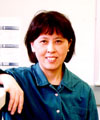
|
|
Bing Zhou |
in the same collision. DZero scoured approximately 14 trillion collisions
produced between April 2002 and June 2004 and found three events with both
a W and a Z boson in them. We estimate that processes which look like, but
aren't WZ production, will provide us three or more such events 3.5%
of the time.
With these three candidate we are able to estimate the rate the Tevatron
produces WZ events. Also, we set constraints on the strength of the
interaction between the W and Z bosons.
|
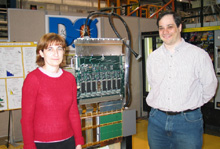
|
|
Oana Boeriu,University of Notre Dame, (left) and
Greg Davis, Northwestern
University, have made important contributions to DZero's Fiber tracker
which was used for this and other analyses. They are pictured with a
key element of the fiber tracker readout.
(Click on image
for larger version.) |
|
Result of the Week Archive
|

Fermilab Water Pressure Adjustments
FESS/Operations will be adjusting the Main Site Domestic Water
Pressure to expected Warrenville levels for data collection today.
Please notify your Building Manager or Work Central at x3434 of any
water pressure related problems.
Free Introductory Tai Chi Class
A free introductory
Tai Chi class will be offered in the Recreation Facility on Friday, February
18 from 6:30 AM to 7:15 AM. Registration for the
free class can be made by calling the Recreation Office at x5427 or x2548.
You must pre-register. You do not need to be a member of the Recreation
Facility for this introductory class, however, you will need one to
participate in the scheduled 8-week session.
Fermilab Offers Family Open House, Sunday, Feb. 13, 2005
Today Last Day to Register!
From historical scientists to hands-on activities, from an accelerator
tour to a liquid-nitrogen show, the Family Open House on Sunday,
February 13 from 1:00 p.m. to 4:00 p.m. at Fermilab offers something
for the entire family.
Visitors need to register by February 10 to receive free tickets.
To register, please send an
email to edreg@fnal.gov
or call Nancy Lanning at 630-840-5588.
All are welcome, but the Open House activities will be most
appropriate for students age 11 and up.
more information
Upcoming Activities
|
|




